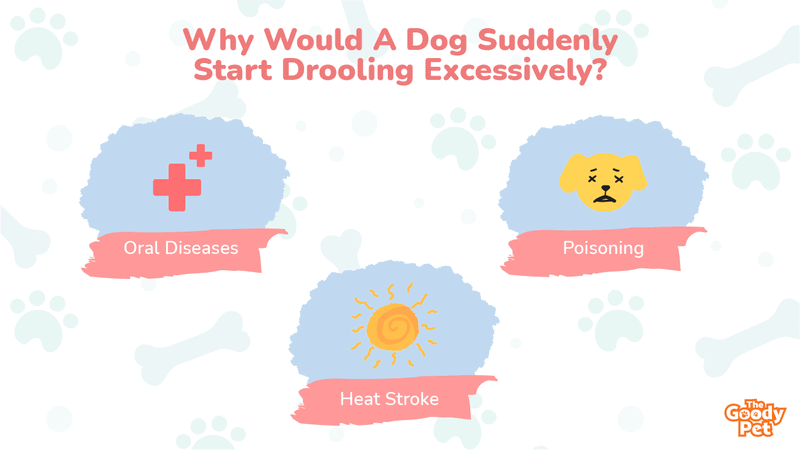Most dog breeds drool for a myriad of reasons. But when is your dog’s drool cool and when is it an indicator that something isn’t right with your furry friend? This is a question that constantly plagues dog owners, and the reason behind today’s article.
What is excessive drooling in dogs? Ptyalism or excessive drooling in dogs is a medical or physical condition that leads to the production of more saliva than normal; This, in turn, subsequently leads to spilling of excess saliva. Dog hypersalivation may occur due to stress, hunger, dehydration, and it can even be a sign of a compulsive disorder!
Today’s article features an in-depth look into the issue of ptyalism in dogs, common triggers of excessive canine saliva production, and how to deal with, and treat hypersalivation in your furry friend. However, before we go into all this, let’s take a closer look at causes of sudden excessive drooling in pooches.
Why Would A Dog Suddenly Start Drooling Excessively?
Ptyalism (also referred to Hypersalivation) in dogs is a condition where excessive saliva gathers in the pooch’s mouth or oral cavity. Hypersalivation is common in dog breeds with head and lip conformations that can’t contain the amount of saliva they produce.
And while dog breeds like the Great Dane, German Shepherd and the Irish Setter are predisposed to ptyalism, hypersalivation can be the indicator of a potentially more serious health or physical issue in a pooch.
That said, some reasons your dog may suddenly start drooling excessively include:
Feeding Difficulties
If your pooch has a foreign object like a stick or piece of bone stuck in its throat, it will have trouble swallowing food; This, in turn, leads to saliva build-up in the mouth. And when the mouth can contain no more saliva, it starts to find its way out, and on to the ground.
Excessive drooling due to feeding troubles in your pooch may also be as a result of throat irritation, and in much rarer cases, a deformed oesophagus.
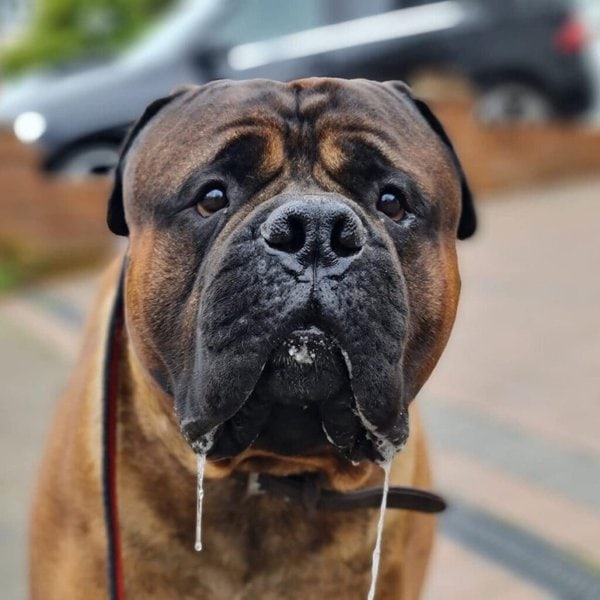
Oral Diseases
One of the most common indicators that your pooch is suffering from any of the various oral and dental diseases typical with dogs is excessive production of saliva and subsequent drooling.
And some of the more common oral infections that cause hypersalivation in dogs include dental abscesses, gingivitis, hyperplasia, tumors, and inflation of the salivary glands, among others.
Heat Stroke
During summer or when the weather is quite hot, excessive drooling can be an indicator that your pooch is overheating and suffering a heat stroke. And if left unattended to, heat stroke can be quite dangerous to doggies.
Hypersalivation in dogs, due to heat stroke, is typically accompanied by vomiting, diarrhea, excessive panting, lethargy and in extreme cases, loss of consciousness.
Poisoning
Dogs may also produce more saliva than normal as a reaction to ingesting a toxin or caustic substances such as household cleaning agents.
Additionally, ingesting a substance with a taste that’s disagreeable to a dog’s tongue may induce hypersalivation and excessive drooling.
Other Health Conditions Responsible For Hypersalivation In Dogs
Apart from the aforementioned reasons, other health and physical conditions typically responsible for excessive drooling in dogs include:
- Seizures
- Rabies
- Allergic reactions
- Gastric ulcer
- Kidney failure
What Causes Dog Ptyalism?
Stress And Anxiety
Excessive salivation coupled with drooling, particularly in dogs that don’t usually drool, can be an indicator that a doggie is going through a great deal of stress.
Isolating a dog in a confined area, moving to a new house, introduction to new people and pets, and sudden loud noises are examples of conditions that may induce stress in a pooch, thereby resulting in hypersalivation. Additionally, motion sickness when traveling can cause ptyalism in dogs.
If you leave your pooch at home for a considerable period, and return to meet your furniture and carpet soaked in excess drool, your pooch may be suffering from stress due to separation anxiety. And this is common with doggies that aren’t used to being left alone or in pooches that have suffered a traumatic experience in the past.
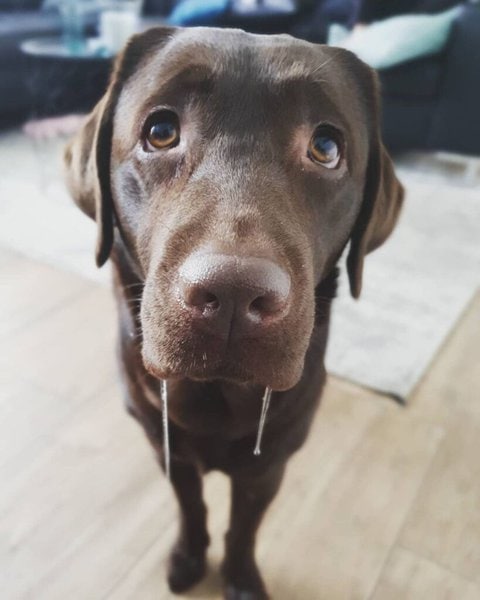
Excitement
Excessive drooling in a dog can also mean the doggie is super excited about something. Excitement in dogs can be due to the presence of another dog, during playtime or even when a pooch’s feeding time draws near.
Note, however, that over-excitement doesn’t necessarily mean a dog is happy, and it can, in fact, be a sign of aggression or addictive behavior in pooches.
Coupled with excessive drooling, dogs that are excited tend to display hyperactive behavior and body language such as jumping and running around, barking, ears laid flat against the head, tongue hanging and many more.
Food
As with humans, dogs are excited at the sight and smell of food. And your canine might involuntarily drop bits of saliva while you eat, in anticipation of being fed.
If you must eat in the presence of your pooch, feeding it at the same time you’re eating may help curb drooling. Alternatively, you can establish clear boundaries with your pooch, by training it to carry out other specific actions while you eat.
How Do You Treat Ptyalism In Dogs?
Consult A Vet
Due to there being so many possible causes of hypersalivation in dogs, medical treatment for ptyalism will depend on the particular condition responsible for the pooch’s excessive drooling.
The first thing to do immediately you notice your dear fido has suddenly started producing more saliva than normal is to schedule an appointment with the vet. In potentially fatal cases such as heat stroke and poisoning, prompt and immediate medical attention is required.
After carrying out a series of examinations and tests on your furry friend, the vet will mostly be able to determine the cause of your pooch’s Ptyalism and recommend the next course of action.
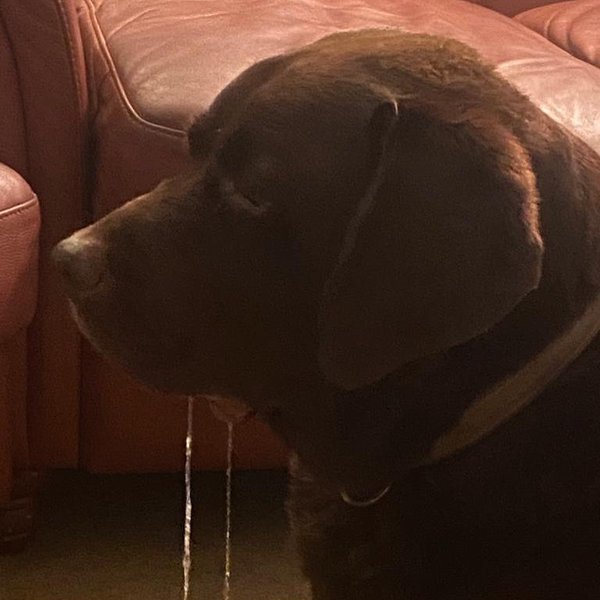
Some Common Forms Of Treatment For Ptyalism In Dogs
- Dogs suffering from hypersalivation as a result of a foreign object in the throat may undergo endoscopy to remove such objects.
- In cases of dental diseases, dental cleaning (or prophylaxis) may be prescribed.
- When ptyalism in the doggie is due to an abscessed salivary gland, surgery to remove the gland is needed.
- Medication to treat cuts and bruises in the dog’s mouth, as well as throat infections that make swallowing difficult.
- In the case of hypersalivation due to kidney failure, dialysis may be required.
- Radiation therapy on the salivary glands helps keep the mouth dry, thereby preventing excessive drooling.
Make Your Dog More Comfortable While Traveling
If it is determined that the cause of ptyalism in your dog is motion sickness when traveling, you can usually treat it by making provisions for your furry friend to be more comfortable when in transit.
You can do this either by adjusting your dog’s position when traveling, rolling down the windows when in transit with your pooch or not taking your canine on road travels at all. Additionally, there are certain medications you can give your pooch before traveling to combat the effects of motion sickness, and by extension, excessive drooling.
How Do You Stop A Dog From Excessive Drooling?
Maintain Great Oral Hygiene
Drooling due to oral or dental infections can, most times, be prevented by taking your dog’s dental hygiene particularly seriously.
Regularly brushing your canine’s teeth or using dental water additives helps reduce or eliminate the development of gum inflammation and mouth irritation, thereby preventing cases of hypersalivation.
Keep Your Dog Cool When It’s Hot
One way of stopping your dog from excessive drooling due to overheating, is to find ways of keeping it cool when temperature levels are spiking.
- Make sure your doggie has constant access to clean fresh water.
- Limit exercising in hot conditions.
- Avoid leaving your pooch outside during extremely sunny days.
- Never leave your dog alone in a parked car.
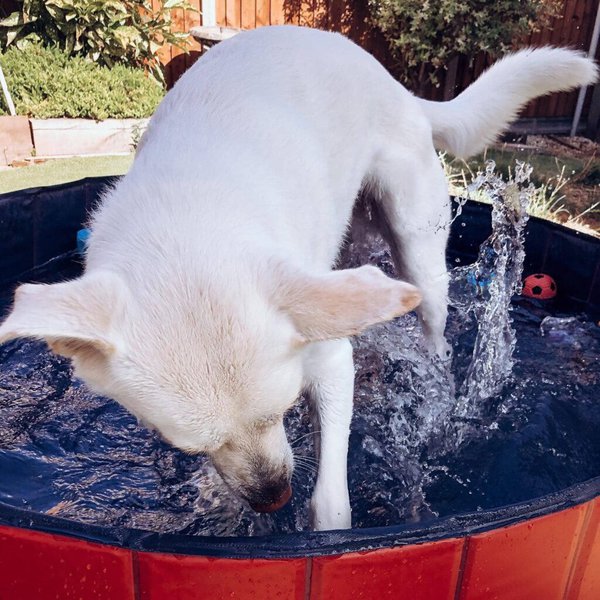
Training Won’t Work
Drooling in dogs is either due to the pooch’s genetic makeup or an involuntary sign of an inherent medical condition; Hence, there’s no amount of training you can give a pooch that’ll teach it not to drool.
You simply have to learn to live with drooling in dogs, and take hypersalivation as an indicator that something is wrong with your furry friend.
Managing Drooling In Dogs
In cases where drooling in a doggie is due to its physical and genetic makeup, you have to find ways to deal with the occasional bits of saliva that will find their way onto your couch and bed.
- For a pooch with a naturally loose jaw, you can tie a bandana or bib beneath its mouth to catch excess slobber.
- Always have a towel at hand to mop up the drool.
- Employ the use of dog furniture protectors on your dog’s favorite sleeping locations to prevent drool accumulation.
- As much as possible, create a stress-free environment for your pooch.
Dried drool on furniture can sometimes leave stains that are difficult to clean. And to get rid of these stains, you’d either have to use a special enzymatic cleaner or a vinegar-water solution.
Related Questions
Why Is My Dog Salivating When Meeting A Puppy? When a dog salivates when meeting a puppy for the first time, it can either be a sign of stress from the introduction of a new pet, anxiety or excitement. However, this drooling usually goes away once the dog gets used to the new puppy.
Why Is My Dog’s Saliva So Thick? The production of thick saliva in dogs is usually an indicator that such a dog is suffering from dehydration. And apart from its peculiar thickness, saliva produced as a result of dehydration is usually sticky and of little quantity. Dogs suffering from mild cases of dehydration can usually be treated at home with an oral rehydration solution. But for more severe cases, prompt medical attention is required.
Do Dogs Drool More As They Age? There is no scientific evidence to suggest that the amount of drool produced increases as a dog grows older. However, drooling in older dogs can be an indicator of a cancerous growth in the mouth or due to the presence of a foreign object in the canine’s throat.

